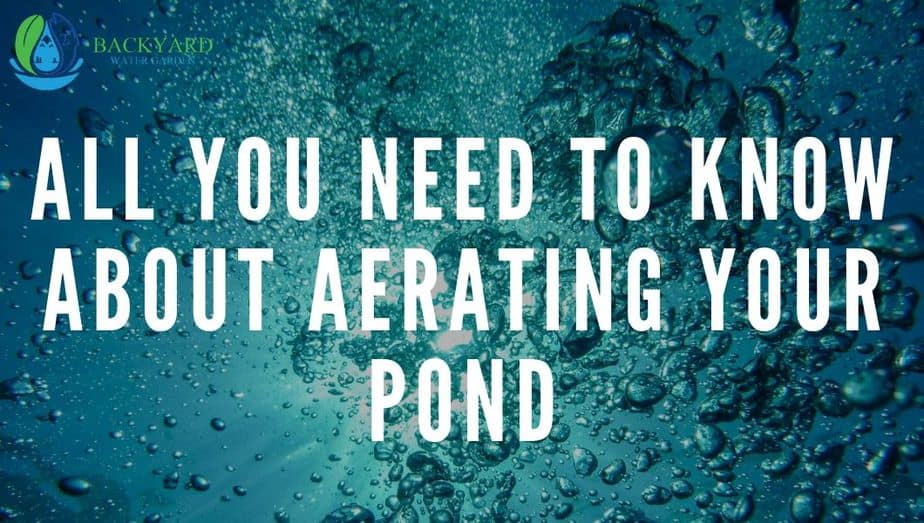

I often get asked this question so it would be a great topic to write about. Is it necessary to aerate my pond?
In this article we will be discussing how aeration works. Why aeration is important to create a backyard ecosystem that will thrive. By the end you will have an understanding of what aeration is, and how you can use it in your own water garden.
Let’s start at the beginning… what is aeration when it comes to the backyard pond. Aeration is a process of introducing free oxygen into the water.
The Pond Water Column
There are three layers that make up your pond water. At the top of the pond the water is not as dense where it mixes with the air and filled with oxygen. The lower layer of your ponds water column is the most dense less oxygenated layer. Then there is the transition layer in the middle. These three layers are what’s known as water stratification.
The act of running the water feature in your pond like a waterfall or fountain is a great way to aerate. Running the waterfall or fountain only affects the top layer of water. The underlying layers of water remain unaffected.
Water stratification is more severe and easier to measure in larger, deeper ponds.
Check Out Our Video
Water Stratification And Its Effects On Your Fish
Losing many fish at once it can be devastating, and is also a red flag that something is off balance. This sort of thing can happen in the spring and fall when the water temperatures changes.
The pond water “gets turned upside down” and mixed. When this happens it’s called turnover.
During turnover the water from the bottom of the pond changes places with the water from the top. Having stratified water in the pond during turnover will cause depleted oxygen levels. This could result in your fish suffocating.
You can end water stratification and will no longer have oxygen starved water. Adding a proper aeration system will accomplish this.
What Does Oxygen Do In My Pond
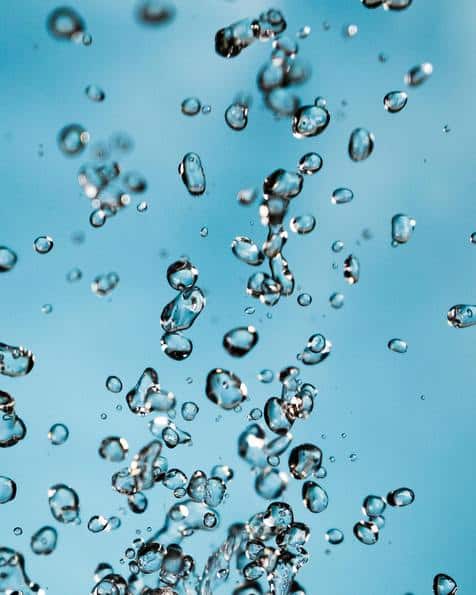
The amount of dissolved oxygen in your pond water plays an important role in the health of your pond. There are two types of bacteria that live in your pond, aerobic and anaerobic.
The aerobic bacteria, what we call beneficial bacteria need oxygen to thrive. Anaerobic bacteria are not as efficient at breaking down waste. This type of bacteria thrive in water with depleted oxygen levels.
When anaerobic bacteria break down organic material, carbon dioxide and hydrogen sulfide are the result.
If you have ever noticed a rotten egg smell when you clean your pond, that’s your anaerobic bacteria at work. This creates water quality issues for your fish. Having low oxygen levels could suffocate your fish.
How To Aerate My Pond
The most effective way to aerate is to use an air pump with a diffuser placed at the bottom of your pond. This will introduce healthy amounts of oxygen into the water. The air flow also agitates the water and disrupts the water stratification.
If you have a large koi pond, placing a bubbler (link to Amazon) close to the drain is a great solution. This creates a current, forcing water from the bottom to flow upward. Eliminating waste through the drain and oxygenating the water at the same time.
If your pond setup doesn’t have a bottom drain, a pump with a diffuser will work. Check out the video below. This pump and aerator setup (link to Amazon) is the bare minimum any pond owner should have.
During routine maintenance you will need a pump and aerator. The aerator is a must if you hold your fish in a tank out of the pond for any length of time.
Having an aerator on hand is not only a good idea, it’s a MUST. The use of an aerator is necessary when quarantining a fish for any reason. An air pump and diffusers are cheap and will keep your fish alive.
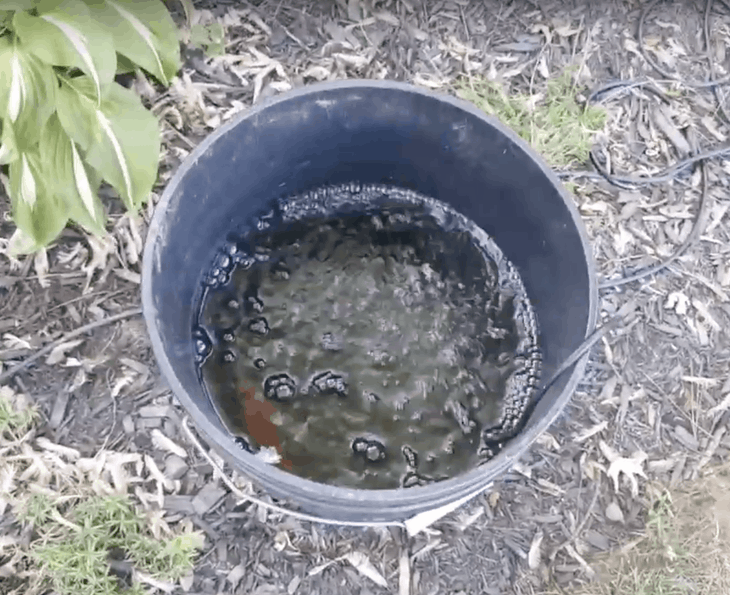
Aeration And The Changing Seasons
Water can only accept so much dissolved oxygen. Think of it like your coffee cup. It will only hold so much coffee. But, the amount of oxygen dissolved is also dependent on water temperature.
The chart below shows the effect temperature has on the amount of oxygen dissolved in water.
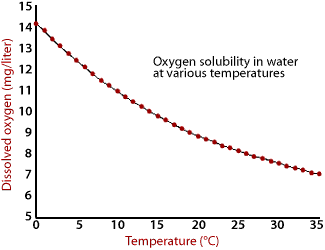
As you can see from the chart, water can hold more oxygen at lower temperatures.
Ppm (parts per million) is the unit used to measure the amount of oxygen in water. PPM is the number of free O2 molecules per one million molecules of H2O.
Do I Need To Aerate My Pond In Winter
It’s true that dissolved oxygen is more accepted in cooler water temperatures. Yet it is still important to aerate during the winter months for a few reasons.
During the cold months your fish seek out the deeper water. This is where the oxygen is less abundant. Without introducing oxygen the anaerobic bacteria begin to take over. They break down waste and produce carbon dioxide. This further depletes the water of oxygen, and reduces water quality.
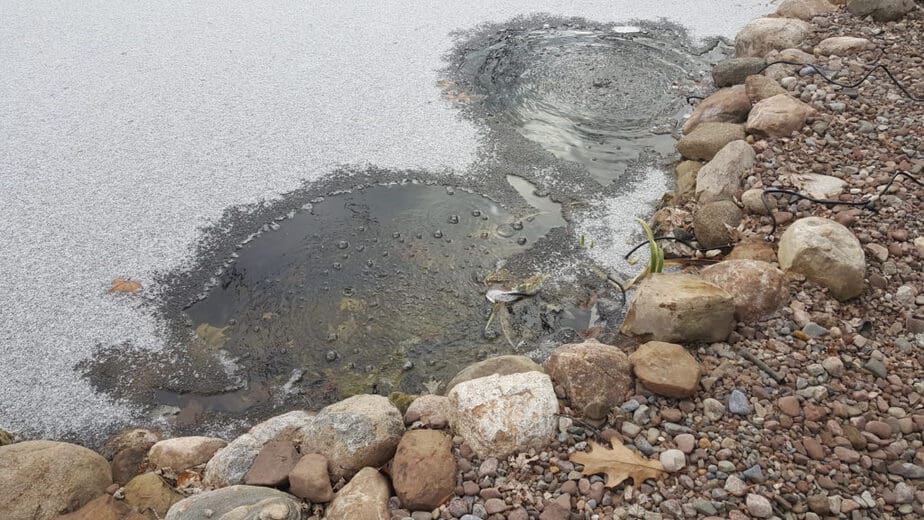
Aerating your pond at the lowest depth introduces super cooled air in winter. We recommend, when using an air pump like the one in the video that it’s placed out of the extreme cold to avoid this.
Using an air pump is also necessary to keep the surface of the water from freezing over. By keeping a hole in the ice, harmful gasses can escape, and help your fish survive the cold months.
Can I Over Aerate My Pond
The answer is no. Water can only accept so much oxygen. Like mentioned earlier with the coffee example. There are factors that increase or decrease the oxygen accepted. Those factors are relative pressure and the water temperature.
How To Know If You Need To Aerate
Your pond will speak to you if you know how to listen. Fish need at least of 5-6 ppm (parts per million) of dissolved oxygen to thrive.
Water quality diminishes (link to our water quality / keeping koi article) at levels of 3ppm. Lower oxygen levels create a stressful environment for fish and other aquatic organisms. Fish cannot live at levels of 2ppm or below.
Aerating Your Pond – Key Takeaways
- Aerating helps your beneficial bacteria do its job. Breaking down waste and clearing the water, reducing pond sludge.
- Aerate during the winter to prevent harmful gas from building up.
- Dissolved oxygen increases water quality.
- Aerating prevents turnover in the spring and fall.
Conclusion
Be sure to include a proper aeration system when building your pond (link to building a pond article). It is a necessary component to creating a thriving environment. Not only will it keep your fish happy, it will also cut down on maintenance keeping your water clearer. Until next time, enjoy your backyard water garden.


